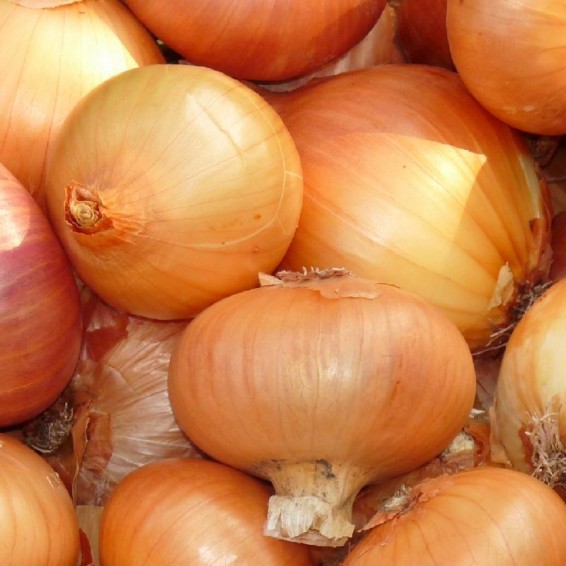Organic Texas Early Grano Onion Seeds
- HOW TO GROW
- FAST FACTS
- REVIEWS
HOW TO GROW
Sowing: Since onions take a few months to mature from seed, gardeners with a short growing season may want to start their seed indoors. Plant the seeds 1/2" deep in a flat 2-3 months before the last frost date; keep the soil moist and at room temperature. When the tops begin to flop over, cut them off to 3" to focus the growing on the roots. Four weeks before the last frost or when the soil reaches at least 50 degrees F, transplant the seedlings 6" apart in rows 12" apart. For direct sowing, sow three seeds per inch 1/2" deep in light, rich soil and full sun. Thin the seedlings 2-6" apart, depending on the desired size. Thinned onions can be transplanted or used for fresh eating. For companion planting benefits, plant onions with members of the cabbage family, lettuce, or tomatoes; avoid planting onions with peas or beans. In areas with warmer winters, onions may be grown as a fall or winter crop.
Growing: Onions need moisture especially in their first several weeks of growth, and they cannot fight against weeds; mulching onions can help with both moisture and weed control. Texas Early Grano onions are quite disease resistant.
Harvesting: When the tops of the onions turn yellow or flop over, they have matured and are ready to be harvested. Pull them from the earth, brush off the dirt, and leave them to cure in the sun for a week. If the weather turns rainy, bring them inside to cure in a dry, well ventilated place. When the skin dries, cut the tops down to 1" and trim the roots. Store in a cool, dry place. Texas Early Grano onions do not store well for long periods of time.
Seed Saving: Onions need to overwinter before producing seed. In warmer locations, simply apply a thick layer of mulch and remove it in the early spring. In areas with very cold winters, pull up the onions and cut off half the stem; store them at 32-40 degrees F in a dry place until spring, when they can be replanted. Before planting, cut an X in the top of the onion to allow the stalk to emerge. The plants will flower and go to seed. Remove the seed heads when the seeds become visible, taking care not to shatter the heads and lose the seed. Spread the heads out in a dry place with good ventilation, and let them dry for several weeks. Thresh out the seeds and store them in a cool, dry place for up to 2 years.
FAST FACTS
Latin Name: Allium cepa
Type: Open Pollinated, Heirloom, Cool Season|Warm Season
USDA Zones: 3, 4, 5, 6, 7, 8, 9, 10, 11, 12
Seeds per Ounce: 7,900
Planting Method: From Transplant
Sunlight: Full Sun
Height: 20 Inches
Color: Yellow
Not RED?
Happy to try this onion even if its not the red one.
DESCRIPTION
HOW TO GROW
Sowing: Since onions take a few months to mature from seed, gardeners with a short growing season may want to start their seed indoors. Plant the seeds 1/2" deep in a flat 2-3 months before the last frost date; keep the soil moist and at room temperature. When the tops begin to flop over, cut them off to 3" to focus the growing on the roots. Four weeks before the last frost or when the soil reaches at least 50 degrees F, transplant the seedlings 6" apart in rows 12" apart. For direct sowing, sow three seeds per inch 1/2" deep in light, rich soil and full sun. Thin the seedlings 2-6" apart, depending on the desired size. Thinned onions can be transplanted or used for fresh eating. For companion planting benefits, plant onions with members of the cabbage family, lettuce, or tomatoes; avoid planting onions with peas or beans. In areas with warmer winters, onions may be grown as a fall or winter crop.
Growing: Onions need moisture especially in their first several weeks of growth, and they cannot fight against weeds; mulching onions can help with both moisture and weed control. Texas Early Grano onions are quite disease resistant.
Harvesting: When the tops of the onions turn yellow or flop over, they have matured and are ready to be harvested. Pull them from the earth, brush off the dirt, and leave them to cure in the sun for a week. If the weather turns rainy, bring them inside to cure in a dry, well ventilated place. When the skin dries, cut the tops down to 1" and trim the roots. Store in a cool, dry place. Texas Early Grano onions do not store well for long periods of time.
Seed Saving: Onions need to overwinter before producing seed. In warmer locations, simply apply a thick layer of mulch and remove it in the early spring. In areas with very cold winters, pull up the onions and cut off half the stem; store them at 32-40 degrees F in a dry place until spring, when they can be replanted. Before planting, cut an X in the top of the onion to allow the stalk to emerge. The plants will flower and go to seed. Remove the seed heads when the seeds become visible, taking care not to shatter the heads and lose the seed. Spread the heads out in a dry place with good ventilation, and let them dry for several weeks. Thresh out the seeds and store them in a cool, dry place for up to 2 years.
FAST FACTS
Latin Name: Allium cepa
Type: Open Pollinated, Heirloom, Cool Season|Warm Season
USDA Zones: 3, 4, 5, 6, 7, 8, 9, 10, 11, 12
Seeds per Ounce: 7,900
Planting Method: From Transplant
Sunlight: Full Sun
Height: 20 Inches
Color: Yellow
Reviews
Review
Not RED?
Happy to try this onion even if its not the red one.





